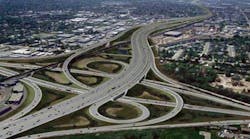U.S. Transportation Secretary Anthony Foxx announced late last week that a new report on the state of America's transportation infrastructure, “2015 Status of the Nation's Highways, Bridges and Transit: Conditions and Performance,” confirms that more investment is needed not only to maintain the nation's highway and transit systems but to overcome a nearly trillion-dollar investment backlog.
“We have an infrastructure system that is fundamental to the nation’s economic health, and it needs greater attention and resources,” said Secretary Foxx. “Improving our nation’s roads, bridges, and transit helps create jobs, connects communities and ensures that our nation is equipped for the future.”
Secretary Foxx added that the Congressionally mandated report confirms the projections outlined in “Beyond Traffic,” a U.S. Department of Transportation study issued in early 2015 that examined the challenges facing America's transportation infrastructure over the next 30 years, such as a rapidly growing population and increasing freight traffic.
The new report – commonly known as the “Conditions and Performance” report – identifies an $836 billion backlog of unmet capital investment needs for highways and bridges, or about 3.4% more than the estimate made in the previous report.
Addressing the growing backlog—while still meeting other needs as they arise over the next two decades – will require $142.5 billion in combined transportation spending from state, federal and local governments. In 2012, the most recent year in which the report’s data were available, federal, state and local governments combined spent $105.2 billion on this infrastructure – 35.5% less than what is needed to improve highways and bridges.
“The case for more investment in our nation’s transportation system is clear,” said Federal Highway Administrator Gregory Nadeau. “A strong transportation system will make businesses more productive and freight shippers safer and more efficient while improving America’s quality of life.”
The report also indicates that $26.4 billion is needed per year to improve the condition of transit rail and bus systems. In 2012, total spending to preserve and expand transit systems was $17 billion. If transit investment is sustained at those levels, overall transit system conditions are expected to decline over the next 20 years, and increasing the transit system preservation backlog from an estimated $89.8 billion to $122 billion.
“This report shows the impact of the lack of investment in infrastructure,” said Acting Federal Transit Administrator Carolyn Flowers. “The results of that neglect can be seen throughout our country as both reliability and safety suffer. We must increase investment in public transportation nationwide, because we must take immediate action to bring our transit infrastructure into a state of good repair and provide the world-class service that Americans deserve.”
Between 2002 and 2012, the report found that:
- The percentage of structurally deficient bridges decreased from 14.2% to 11%.
- Road quality improved, with the share of travel taking place on smooth pavement increasing from 43.8% to 44.9%.
- Delays in traffic cost the average commuter more time than ever, with an estimated 41 hours of delay per year in 2012, up from 39 hours in 2002.
- Transit route miles increased by 32%, with light rail growing faster than any other transit mode.



